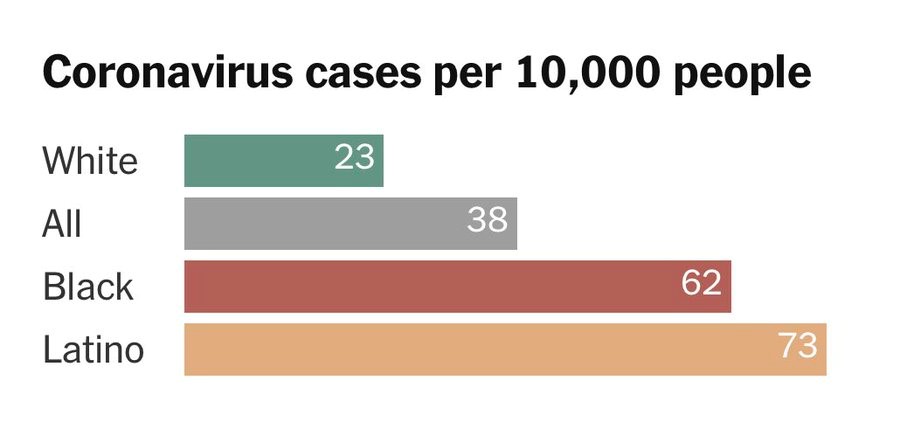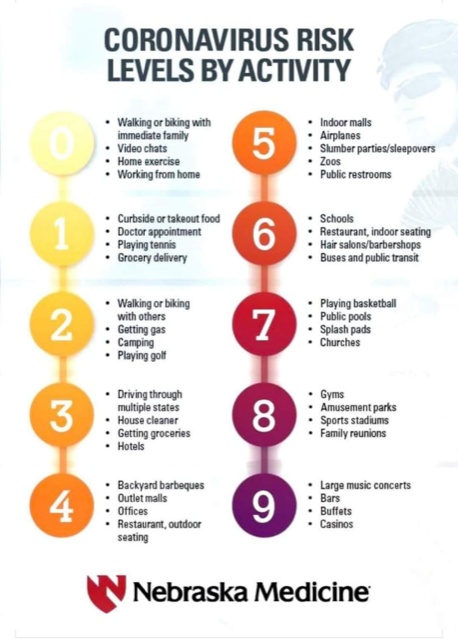Consulo Indicium - 7/29/20
Information for your Consideration…
To Mask Or Not To Mask, That Is The Question! – “The Mask” has taken on new meaning in society writ large. We can now order masks that convey our favorite symbol or topic du jour. There are Trump masks and Joe masks. There are peace masks, BLM masks, puzzle masks, and the latest – “your face” masks which duplicate the bottom half of your face as a mask. Then, there are just plain old blue surgical masks, N95 masks and an assortment of other personal protective gear designed for those with chronic exposure to the Covid-19 virus.
Now the question you should be asking when it comes to wearing a mask is: What do the studies show? The problem with most of the studies is that there are no controls for comparative purposes so the data needs to be extrapolated. Regardless – the data is very clear: USING MASKS MAKES A DIFFERENCE! Here are the studies:
- A report this Spring from Nature Medicine(2020-0401) reviewed the effect of mask use on the seasonal flu. It revealed that masks blocked almost all of the larger contagious droplets and many – but, not all – of the aerosolized tiny droplets or, the kind from coronavirus. Long-story-short (LSS) = Masks work.
- The BMJ Global Health (2020-0515) reviewed mask use in China, specifically related to home use and household spread among family members. Use of masks in the home resulted in a 79% reduction in viral transmission. LSS = Masks work.
- Again, in late May, a study in Cell,described the finding that the Covid-19 virus may attack the nasal cavity first, get planted (my wording) before moving on to more vulnerable tissues (i.e. the lungs) and causing severe respiratory problems. Again, LSS = Masks work!
- And aProceedings of the Royal Society (2020-0701) early last month concluded that if the majority of a population wore face masks in public regardless of type, the reduction in viral transmission would be dramatic and prevent continuation or expansion of the pandemic. LSS = Masks work!!
But, unfortunately, our messaging has been mixed at best. Near the beginning of the pandemic, I remember talking with a group of colleagues that meets by Zoom and telling them that the contribution of masks was “marginal”. A week later, the CDC came out with their recommendations “suggesting” the use of masks. I reviewed the data and reversed course by calling my colleagues to apologize for getting ahead of the curve. I told them: “Masks work.” Consistency of messaging with each state doing its own thing for different purposes at different times has created a morass. But, I digress. Review the above data and you’ll see the same results I’ve found…
Now – what types of masks should you be wearing? The issue is the ability to block the aerosolized droplets (the tiny ones where Covid-19 hangs out). Here’s the advice I’ve found:
- While the N95 masks are exceptionally effective in blocking aerosolized droplets (i.e. up to 95%) – they are in very short supply and generally held back for health care providers and the emergency medical technicians. So, good luck…
- The surgical masks are designed to prevent the wearer (e.g. the surgeon) from spreading germs to others (e.g. the surgical patient). They tend to be a bit looser than other types so the wearer can obtain unfiltered air from the sides of the mask – making them more susceptible to breathing in viral droplets from the air from others. But, according to tests, they block out about 75% of aerosolized droplets.
- Cloth masks seem to be the rage at the moment. In fact, my favorite mask is a cloth one with “peace signs” all over it (i.e. retro 1960’s type mask). But according to reported research they are only 30 – 50% effective – especially if only a single layer. Mine is multi-layer by folding over the material on top of itself to create double & triple layers. I’ve gone to adding a folded up paper towel under my cloth mask when I use it for added protection.
The biggest problems with masks is finding ones that fit over your entire face. For example, I have a relatively long face and many of the masks only go to the bottom of my chin thereby exposing me to inhaling air from below the mask as well as from the sides. But, regardless, LSS = Wear masks. The final thought is to review the New York Times page that provides an overview by county of mask use across the entire country as of July 17, 2020. It’s worth taking a long review…
Disturbing Social Disparities – The graph below speaks for itself and is disturbing beyond words. Think about it for a moment in the context of our current national conversation on race.

Kudos – We should all send a note of thanks to the Nebraska Medical Association for the risk level chart which they recently published. You can be the judge as to when you want to use a mask. While I’m compulsive and wear a mask for 1 and above – you be the judge!

The Coming Primary Care Confrontation –If health care providers and systems thought there were challenges coming at the traditions of care delivery from private equity groups, insurance companies and for-profit chains – as the saying goes, “…they ain’t seen nothin’ yet”. Why? It’s because three of the largest retail and financial organizations in the nation – CVS Health, Walmart Boots and the triad of Amazon-JPMorgan Chase-Berkshire Hathaway – have all made recent moves into the primary care space. The triad is focused on primary care for the workers – as a starter project for expansion to others down the road. CVS Health is adding primary care “HealthHUBs” to 1500 of their existing store operations across the country; and, Walmart Boots (the most recent entrant) announced an affiliation with VillageMD to place primary care offices adjacent to existing operations in over 700 locations.
Why is all of this action concerning? It’s because the studies to date have shown that the retail clinics do not lower cost and, more importantly, the evolution of these sites is continuing the slow moving tsunami of disintermediation of the primary care process. Actually – to be honest – this has been my mantra for the last decade. The problem is not in providing retail services. Actually convenience would be enhanced if it were done properly. The problem is in the fact that the retail services are done to the exclusion of a comprehensive oversight of the care delivery process – something that has traditionally been the purview of the primary care provider. I drank the Kool-Aid on this one back in the late 1970s when I became a resident in Family Practice. I believe then, and I still believe now – that a comprehensive coordinated care model by a primary care provider is the most effective model for enhancing quality and reducing costs. There are many studies on the topic but the National Institutes of Health provides one of the best overviews on the topic if you’re interested in diving deeper into the topic.
Finally, while out-of-pocket expenses are a growing component of the overall health care spend, it is not necessarily on the primary care front. As a result, these initiatives will require the same negotiations with insurers that other physician and system providers must consider. The insurance companies could potentially latch on to the idea – if it reduces their overall cost. Alternatively, if we move toward more value-based care delivery, the importance of primary care as the “coordinator” of care delivery becomes considerably more important. In that case, these new entrants could have some advantages – primarily due to access considerations. Regardless, there is a coming confrontation. Is it the insurance companies, the existing health systems or the insurers who will be responsible for comprehensive coordinated care? We need to keep a watchful eye…
Federal Government Continues to Open the Telehealth Door – There is clearly growing support for a permanent expansion for using the telehealth approach as part of our care delivery armamentarium. With the announcement in mid-June that the Center for Medicare and Medicaid Services (CMS) proposed making a permanent change in the reimbursement rules – we should anticipate that the other health insurers are not far behind. In fact, the Association of Health Insurance Plans, in a study funded by the Aetna Foundation, outlines an increasing number of plans that now offer telehealth coverage. In addition, Senator Lamar Alexander (R-TN) who chairs the Senate HELP (Health, Education, Labor and Pensions) committee has introduced legislation that would require CMS to make permanent the home health telehealth provisions which were part of the COVID-19 relief regulation from March. The Federal Communications Commission has also gotten into the swing of changes by setting aside $200M from the CARES Act provided by Congress specifically for telehealth expansion – which will be particularly important for the rural areas of the nation. It has already processed more than 500 applications which can be used for platforms, training of state and physicians and other similar initiatives.
Who Are The Better Leaders? – My wife provided me the following material from an article that asked the question: Which countries have been the most affected by the Covid-19 pandemic and who were their leaders? VERSUS which countries have been the most successful in preventing the spread of Covid-19? You be the judge on what this all means…
THE COUNTRIES WITH THE GREATEST SPREAD OF VIRUS FROM THE PANDEMIC

THE COUNTRIES WITH THE MOST SUCCESS IN MANAGING THE PANDEMIC

Health Care, We’ve Got A Problem –First, let me be clear that I’ve been an advocate for women leaders in health care for a long time. Second, we are not making sufficient progress in supporting the movement of women of health care into leadership roles as effectively as we should be doing. The data shows very clearly that while women make up the vast majority of the health care workforce, they only hold 19% of the CEO positions across the nation. Furthermore, only 4% of the health care companies that support the industry have women CEOs. It’s why we need to do a better job of supporting leadership development for women in healthcare and, of course, the nation!
A Slight Change
For the evolving blog…
Taking the Feedback – A number of colleagues have recently written to me noting that over the last six months, my blog has become a bit more partisan in nature. The breadth of the pandemic tsunami carried me away as I sheltered away up in Maine. If any of my facts were wrong – please point them out. I will make corrections like I noted in the above commentary on the use of masks where my initial understanding was incorrect (SEE above on wearing masks). I’ve been at the blog now for nearly 12 years and the readership has been long and loyal. Let me give a shout out and note of thanks to those who have given me feedback.
As a result of the feedback, I’m moving any “commentary” to the end so that those who do not want my “opinions” (except non-controversial ones, of course – like wearing masks or at least not medically controversial :-) ) they will not have to consider them. I hope this slight change will allow the readers to still take advantage of all the information I pull together on the directions of the health care industry. Any other feedback from readers is always appreciated at my regular email address = This email address is being protected from spambots. You need JavaScript enabled to view it.. Have a good day, stay well and be safe!!!
